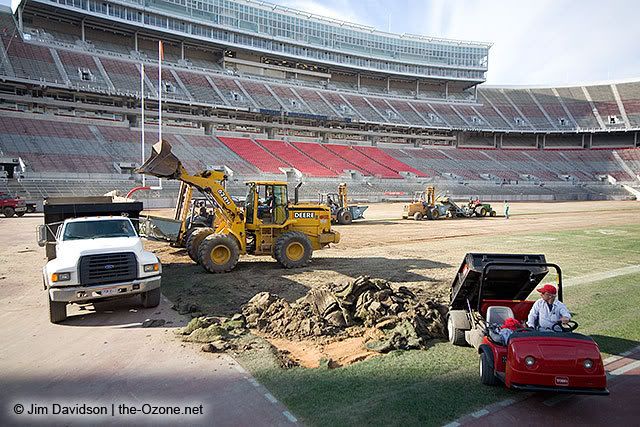 Buckeye Archive
Buckeye Archive  Turfgate - Part Deux
Turfgate - Part Deux

For those with short memories, Ohio State was recently forced to replace the playing surface at Ohio Stadium. Well, three football games, a wet October, and frost have apparently destroyed the new field.
For the second time in a month the turf at Ohio Stadium is being removed because frankly, as Minnesota coach Glen Mason put it, “They [Ohio State] have a lousy field.” The field is riddled with bare spots, thick spots, potholes, divots, and seams. The field actually looks like a bad hairpiece, and just think, the Buckeye’s Athletic Department got all this for the bargain basement price of $85,000.
The installation of the new surface began today. Apparently the Buckeyes are bargain hunting this time because the proposed cost of the new surface is about $25,000 less than the previously installed field. It is also interesting to note that the seemingly excessive $145,000 spent on turf replacement so far this year accounts for about .15% of the athletic department’s total budget.
Currently officials within the athletic department are tight lipped regarding the future of a natural surface in Ohio Stadium. While Coach Tressel has stated that he prefers to play football on “an immaculate natural surface,” questions are arising regarding the long-term viability of a natural surface in Ohio Stadium.
The problems arose as an unforeseen circumstance following the renovations about six years ago. As a result of increasing the height of the upper deck (“C Deck”) and lowering the field to create “AA seating,” the field now sits nearly 200 feet below the highest levels of the stadium and is nearly encircled at that height. This coupled with the “North-South” orientation of the field has resulted in the natural surface receiving very little direct sunlight from October until March.
Adding to the heated field turf debate is the desire of state football authorities to move championship games to Ohio Stadium. Right now championship games are played in Paul Brown Stadium, in Massillon. Massillon is not exactly anywhere near the center of Ohio, and as a result teams and fans from southwest Ohio are arguing that the current location of the championship games in northeast Ohio creates an unfair advantage for some teams and actually creates undue hardship for their teams and fans. Let’s face the facts, most high school football teams do not travel very well.
With the current surface, that is not a viable option today. Could you imagine how bad the field would look after a few additional high school games were played on it?
I suspect that this is the last time that the field at Ohio Stadium will be replaced with natural grass. Should this field hold well there is still a very good chance that the field will be replaced with field turf before the 2007 football season. The upcoming Ohio State vs. Michigan game at the ‘Shoe on November 18th will probably be the last time the Buckeyes play at home on natural grass.
- NBA Announces 2013-2014 Schedule
- Browns Ink Sharknado
- Sharknado A No-Show For Rookie Camp
- Trent Richardson Out Until Training Camp
- Browns Sign Brandon Jackson
- Carrasco Suspended Eight Games
- Browns Add to Wide Receiver Depth with David Nelson
- Browns Need to Learn from Past Draft Mistakes
- Browns Release Chris Gocong and Usama Young
- Browns Missing on Grimes Disappointing, But Not The End
The TCF Forums
- Official- Browns Coach Search/Rumors
HoodooMan (Tuesday, January 21 2014 1:36 PM) - Movies coming out
rebelwithoutaclue (Tuesday, January 21 2014 12:56 PM) - 2015 Recruiting
jclvd_23 (Tuesday, January 21 2014 12:38 PM) - The 2014 Offseason Thread
Larvell Blanks (Tuesday, January 21 2014 12:25 PM) - Chris Grant's first 3 drafts
Kingpin74 (Tuesday, January 21 2014 10:13 AM) - Mike Brown
YahooFanChicago (Monday, January 20 2014 11:15 PM) - 2014 Hoops Hockey Hijinx
jpd1224 (Monday, January 20 2014 4:44 PM) - 2014 Recruiting
jclvd_23 (Monday, January 20 2014 2:26 PM) - Wish List - #4 Pick
Hikohadon (Monday, January 20 2014 1:26 PM) - #1 overall pick Anthony Bennett
TouchEmAllTime (Sunday, January 19 2014 1:28 PM)


